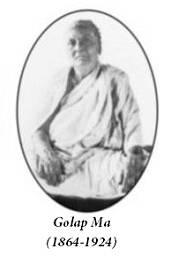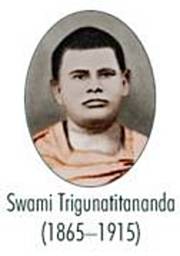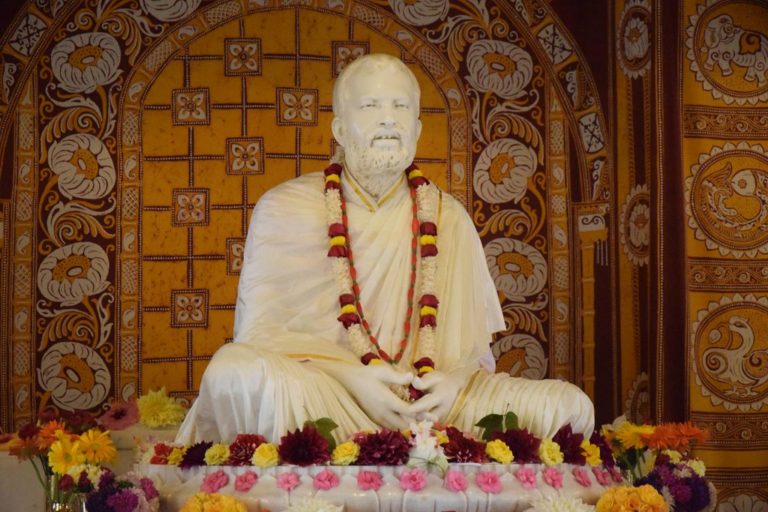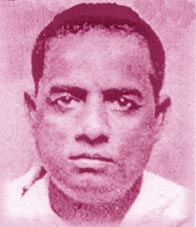It was July 28, 1885. In a dilapidated house in North Calcutta a poor Brahmin widow was making earnest preparation to receive Sri Rama-krishna in her home. She was poor, but belonged to a very high class Brahmin family. Her only daughter had some time back died, and consequently she lived a very sad life.
She was glad beyond measure at the very idea that Sri Ramakrishna had agreed to grace her poor house with his presence. Sri Ramakrishna had already arrived at the house of a neighbouring devotee, so she was expecting him every moment. In her great eagerness she was going out many times just to see whether the Master was yet in sight on his way to her house, and then going in to give a finishing touch to the arrangements of welcome. Her sister was assisting her in the preparations to receive the august visitor.
When the Master came the “grief-stricken Brahmin woman,” as she was then called, was beside herself with joy. $he did not know how to control her great emotion, and actually burst out: “Well, I cannot contain myself for joy. When my daughter Chandi came from her father-in-law’s house and many guards and people accompanied her as a mark of honour to her, and my poor house was astir with new life, even then I did not feel so much joy. My condition is just like that of a poor man who got a lac of rupees in a lottery and died immediately on hearing such good news. Really the man died ! I am also in that state of mind. Pray bless me, otherwise I shall now die ! ’ ’
So great was her devotion to the Master that she was rooted to the spot! Her sister was calling her for assistance in the work still remaining to be done, but she paid no heed to her words.
Sri Ramakrishna after returning from her house at night said to a devotee, “Oh, how glad they had become!” The devotee said, “What a strange coincidence! They were just like the two sisters, Mary and Martha, mentioned in the Bible.” Sri Ramakrishna felt curious to hear about them, so the devotee narrated the story of Mary and Martha.
This “grief-stricken Brahmin widow” was afterwards known as Golap Ma. Her early name was Golapsundari Devi. She lost her husband while she was of young age. Her only daughter was given in marriage to a very rich aristocratic family. But, as ill luck would have it, this daughter also died prematurely, and Golap Ma was left almost mad with grief. She knew Jogin Ma, her neighbour, who took her to Sri Ramakrishna at Dakshineswar. When she unfolded her sad tale to the Master, he said in an ecstatic mood: “You are fortunate. God Himself helps those who have none else in the world to call their own. The Words breathed new life into her, and she felt greatly relieved.
She was introduced by the Master to the Holy Mother, who was then staying at Dakshineswar. Golap Ma repeated her visits to Dakshineswar, and now and then stayed there to get greater opportunity of profiting by the association with the Master. During her stays at Dakshineswar she would put up at the Nahabat with the Holy Mother, who loved her dearly. She had the privilege of serving the Master at Dakshineswar as also at Shyampukur and Cossipore during his last illness.
Golap Ma was one of the closest companions of the Holy Mother. After the passing away of the Master, she accompanied the Holy Mother to Vrindavan and practised Tapasya there. She visited many places of pilgrimage in company of the Holy Mother. Afterwards when the Holy Mother stayed in Calcutta, she was her constant companion.
Golap Ma was unsophisticated, frank and plain-spoken. She was a protection and shield to the Holy Mother when in later days many devotees would come to her and sometimes cause her great inconvenience by their senseless marks of devotion.
Her life was uneventful but it was a life of complete dedication to God. Many hours in the day would she pass in Japa and meditation. The rest of her time was devoted to the service of others. She was all love and service. Herself reluctant to take any help from others, she lost no opportunity of serving others. It was so very spontaneous with her that it required no effort on her part. One day during; her stay at Vrindavan, she saw a place in the temple dirtied by some child. She at once began to cleanse the spot. At this the women who saw it began to remark that the spot was perhaps dirtied by her own child.
She received a very small allowance from her daughter’s son. But only half of it she spent on herself, and the other half she spent in charity to the poor. Every poor man who approached her was sure to get something from her. If a poor neighbour fell ill, she would arrange for medical treatment.
Though belonging to an orthodox Brahmin family she shook off all rigidity of orthodoxy. She was very liberal and catholic in her views — such is the result of true spiritual growth. She had the privilege of serving the Holy Mother and enjoying her association for thirty-six long years.
She passed away in December, 1924, at the Calcutta residence of the Holy Mother. Her life of devotion was a great example to all who had the privilege of knowing her. The sufferings of her early days gave her access to a world from where*she could bring joy and bliss to many steeped in misery. Hers is a name which is remembered with feelings of devotion and respect as one whose life was made saintly by the touch of Sri Ramakrishna.



